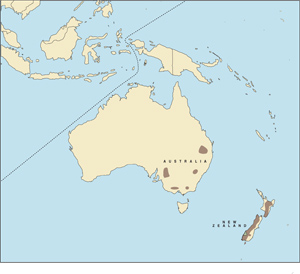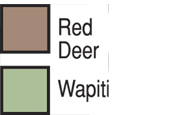 |
 |
Cervus elaphus ssp.Wapiti (Sp), Wapiti (G), Wapiti (F).DESCRIPTION Purebred wapiti bulls have a shoulder height of about 60 inches (152 cm), and weigh 600-900 pounds (272-408 kg). However, crossbreeding with red deer for many generations has reduced the body size of New Zealand's wapiti considerably. Females are a good deal smaller than males.The wapiti is the most magnificent deer in the South Pacific region and has the finest antlers. General color is yellowish-gray to light brown. Legs, underparts and neck are a deep chestnut-brown. The distinctive straw-colored rump patch extends from above the root of the tail to midthigh. As with red and sika deer, wapiti grow upper canine teeth. The antlers of a purebred wapiti resemble those of a red deer with respect to brow, bez and trez tines, but differ in that the top tines grow upward from the main beam without cupping or crowning. Antlers of hybrids, however, can have features of both wapiti and red deer.The longest New Zealand antlers, measuring 60-1/2 inches (153.7 cm), were recorded in 1931. A head with 27 points was taken in 1953 in Fiordland on the South Island.BEHAVIOR A gregarious herd animal. Older bulls are solitary or in small bachelor groups, except during the rut when they battle other bulls for control of females. Wapiti in New Zealand rut from about mid-March to mid-April, with the calves born just before Christmas.Both a grazer and a browser. Feeds early morning and late evening, becoming nocturnal when persecuted. Wapiti in New Zealand do not make seasonal migrations to summer and winter ranges as do those in North America. Eyesight, sense of smell and hearing are all good.HABITAT Steep mountainsides, with bush and forest cover and steep cliffs. New Zealand's wapiti occupy much steeper terrain than those in North America, where their ancestors originated.DISTRIBUTION The only wild wapiti are on the South Island of New Zealand, where they are found in a small area in northern Fiordland west of Lake Te Anau. Unfortunately, they have hybridized extensively with red deer in this area. Enclosed wapiti, and wapiti x red deer hybrids, are found on private deer farms on both North and South islands.TAXONOMIC NOTES According to Lever, only wapiti of the Rocky Mountain race (nelsoni) were successfully introduced in New Zealand.REMARKS An attempt to introduce wapiti on Kawau Island in Hauraki Gulf in the 1870s was unsuccessful, as was a later attempt near Dunedin. Eventually, animals from the National Zoological Park in Washington, D.C., and from the Indian Game Reserve in Brookfield, Massachusetts, were obtained with the help of President Theodore Roosevelt and H.E. Richardson, respectively, and were introduced at George Sound in Fiordland in 1905. Today's free-ranging wapiti on the South Island are descended from these animals.In accordance with our established policy, wapiti x red deer hybrids are classified as red deer in the Record Book, because red deer have the larger antlers. Skull lengths should be noted for identification purposes. Measured by the Douglas system, which is over the curves from the farthest point in back to the farthest point in front, bull wapiti skulls will normally measure 20-21 inches (50.8 to 53.3 cm) in length, while those of red deer stags normally range from 16-3/4 to 17-1/2 inches (42.5 to 44.5 cm), and very rarely exceed 18-1/4 inches (46.4 cm). The neck hair on a wapiti is furlike in texture, while that of a red deer is coarse. A wapiti's upper canine teeth are much larger than those of red deer. Antlers of a purebred wapiti seldom carry forked tines such as those found in some red deer antlers.
|





